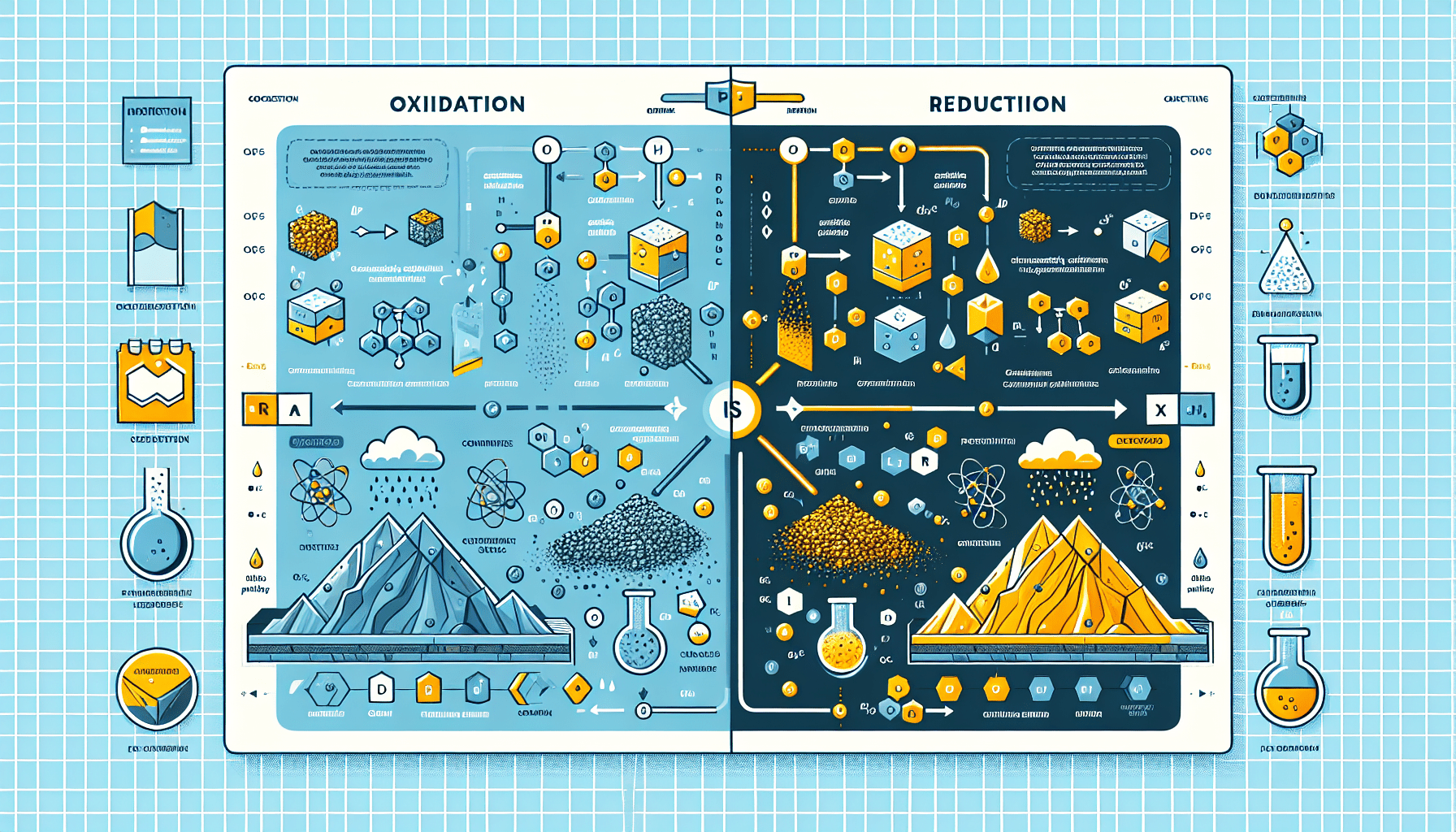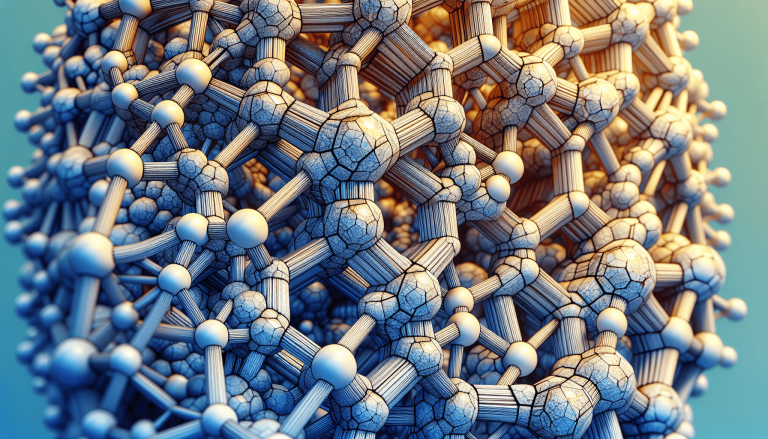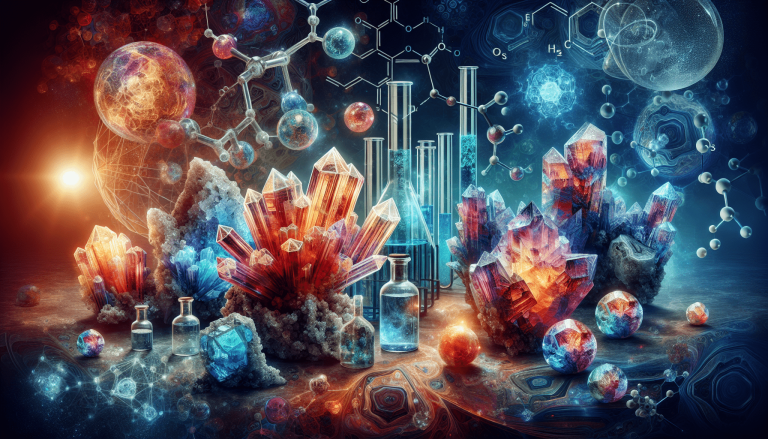Analyzing The Impact Of Oxidation And Reduction On Mineral Chemical Properties
In this article, we will explore the fascinating world of mineral chemical properties, specifically focusing on the impact of oxidation and reduction. By examining how these processes alter the composition and reactivity of minerals, we can gain a deeper understanding of their role in various geological and environmental phenomena. So, grab your magnifying glass and join us as we unravel the mysteries hidden within these captivating chemical reactions.

Overview of Oxidation and Reduction
Oxidation and reduction are fundamental processes that play a crucial role in mineral chemistry. These terms refer to the transfer of electrons between chemical species.
Oxidation involves the loss of electrons and an increase in the oxidation state of the species involved. Reduction, on the other hand, involves the gain of electrons and a decrease in the oxidation state. These processes are often interconnected, forming oxidation-reduction (redox) reactions. In mineral systems, redox reactions can profoundly influence the properties and behavior of minerals.
Understanding the concepts of oxidation and reduction is essential for comprehending various aspects of mineral chemistry. From enhancing the stability of minerals to influencing their color and reactivity, the impact of redox processes on mineral chemical properties is wide-ranging. In the following sections, we will delve deeper into the effects of oxidation and reduction on mineral chemical properties, explore redox reactions in mineral systems, discuss analytical techniques used to study these processes, and examine their applications in industry and the environment.
Effects of Oxidation on Mineral Chemical Properties
Enhancing Stability of Minerals
Oxidation of minerals can enhance their stability by forming more stable compounds. For instance, the oxidation of iron-bearing minerals, such as pyrite (FeS2), can lead to the formation of more stable iron oxide minerals like hematite (Fe2O3). These iron oxides are more resistant to further weathering, contributing to the long-term stability of mineral deposits.
Formation of Oxides and Hydroxides
Oxidation can result in the formation of oxides and hydroxides of various elements. This transformation can significantly alter the chemical and physical properties of minerals. For example, the oxidation of sulfide minerals, such as galena (PbS), can yield lead oxide minerals like cerussite (PbCO3) or lead hydroxide minerals like anglesite (PbSO4). These oxide and hydroxide minerals can exhibit distinct properties compared to their sulfide counterparts.
Changes in Mineral Coloration
Oxidation reactions can also lead to changes in the coloration of minerals. As the oxidation state of certain elements changes, the absorption and reflection of light by the minerals can be altered. For instance, the oxidation of iron-bearing minerals can result in the formation of iron oxide minerals with different colors, such as red hematite or yellow goethite (FeO(OH)). These color changes can have important implications for mineral identification and exploration.
Alteration of Mineral Hardness
The process of oxidation can also influence the hardness of minerals. As minerals undergo oxidation, the formation of new compounds can result in changes in their crystal structure and composition. This alteration can lead to variations in mineral hardness. For example, the oxidation of pyrite can result in the formation of goethite, which is softer than the original pyrite mineral. These changes in hardness can affect the abrasiveness and durability of minerals.
Effects of Reduction on Mineral Chemical Properties
Promotion of Metal Extraction
Reduction plays a crucial role in the extraction of metals from ores. Many metal ores are in oxidized forms and need to be reduced to obtain the desired metal. Reduction reactions effectively remove oxygen from the ore, converting it into a reduced metal. For example, the reduction of iron ore (Fe2O3) with carbon monoxide can produce iron metal (Fe) via the reaction Fe2O3 + 3CO → 2Fe + 3CO2. This reduction process enables the extraction of metals from their oxidized forms for use in various industries.
Formation of Sulfides and Metals
Reduction reactions can also lead to the formation of sulfides and metals from oxidized minerals. The addition of reducing agents, such as sulfur or hydrogen, can facilitate the reduction of metal oxides and other oxidized species. For instance, the reduction of copper oxide (CuO) with hydrogen gas can yield copper metal (Cu) and water vapor, as shown in the reaction CuO + H2 → Cu + H2O. This reduction process is crucial in the production of metals and sulfides from their oxidized forms.
Transformation of Mineral Structure
Reduction can induce significant changes in the structure of minerals. The reduction of certain minerals can result in the rearrangement of atoms and the formation of new crystal structures. This transformation can lead to modifications in the physical and chemical properties of the minerals. For example, the reduction of magnetite (Fe3O4) can produce wustite (FeO), which has a different crystal structure and properties. These structural changes can influence the behavior and reactivity of minerals.
Modification of Mineral Reactivity
Reduction reactions can modify the reactivity of minerals, making them more or less reactive towards other substances. By altering the oxidation state of elements within minerals, reduction processes can influence their chemical reactivity. For instance, the reduction of certain minerals can make them more reactive towards acids or other chemical agents. This change in reactivity can affect how minerals interact with their environment and undergo further transformations.
Oxidation-Reduction Reactions in Mineral Systems
Overview of Redox Reactions in Minerals
In mineral systems, oxidation-reduction reactions play a vital role in various geological processes. These reactions involve the transfer of electrons between different mineral phases or between minerals and the surrounding environment. Redox reactions can occur during mineral formation, weathering, and ore deposition, among other geological events. Understanding the mechanisms and implications of redox reactions is crucial for deciphering the history and behavior of minerals in natural systems.
Types of Redox Reactions in Minerals
Redox reactions in minerals can be classified into different types based on the nature of the electron transfer and the elements involved. One common type is the oxidation of metal sulfides to form metal oxides or hydroxides. For example, the oxidation of pyrite (FeS2) produces iron oxide minerals like hematite (Fe2O3) or iron hydroxide minerals like goethite (FeO(OH)). Another type of redox reaction is the reduction of metal oxides to form metal or metal alloy phases. For instance, the reduction of hematite (Fe2O3) can result in the formation of metallic iron (Fe).
Factors Affecting Redox Reactions
Several factors influence the occurrence and rates of redox reactions in mineral systems. The availability of oxygen or other oxidants, as well as the presence of reducing agents, can greatly affect the likelihood and extent of oxidation and reduction reactions. Temperature, pressure, and pH conditions also play significant roles in governing the redox behavior of minerals. Additionally, the presence of specific transition metals or catalytic agents can influence the kinetics and pathways of redox reactions.
Influence of pH on Redox Reactions
pH is a crucial parameter that can influence the occurrence and outcomes of redox reactions in mineral systems. The pH of a solution affects the availability and stability of different chemical species, which can impact the redox behavior of minerals. In acidic environments, the availability of hydrogen ions can promote reduction reactions, while in alkaline conditions, the presence of hydroxide ions can enhance oxidation reactions. The pH of a system can act as a powerful driving force for redox reactions, shaping the mineralogical composition and behavior of a geological system.

Analytical Techniques for Studying Oxidation-Reduction Processes
X-ray Diffraction (XRD) Analysis
X-ray diffraction (XRD) is a powerful analytical technique widely used in mineralogy and material science to study the crystal structure and mineralogy of samples. XRD analysis can provide detailed information about the mineral composition and the presence of different mineral phases. By comparing the diffraction patterns of oxidized and reduced samples, researchers can identify changes in crystal structure and phase transformations associated with redox processes in minerals.
Scanning Electron Microscopy (SEM)
Scanning electron microscopy (SEM) allows researchers to examine the surface morphology and elemental composition of mineral samples. By using a focused electron beam, SEM generates high-resolution images that reveal microstructural details. This technique can be coupled with energy-dispersive X-ray spectroscopy (EDS) to obtain chemical information about specific areas of interest. SEM analysis can provide valuable insights into the morphological changes and elemental redistribution associated with oxidation and reduction of minerals.
Electron Microprobe Analysis (EMPA)
Electron microprobe analysis (EMPA) is a technique used to determine the chemical composition of solid materials, including minerals. By using an electron beam to excite sample atoms, EMPA quantifies the emitted characteristic X-rays, allowing for elemental identification and quantification. EMPA analysis can help researchers track changes in elemental composition resulting from oxidation and reduction processes in minerals. This information is crucial for understanding redox-driven mineral transformations.
X-ray Photoelectron Spectroscopy (XPS)
X-ray photoelectron spectroscopy (XPS) is a surface-sensitive technique used to analyze the elemental composition, oxidation states, and chemical environments of materials. By irradiating a sample with X-rays, XPS measures the kinetic energy of emitted electrons to determine elemental and chemical information. XPS is particularly useful for studying oxidation and reduction phenomena in minerals as it can provide insights into changes in oxidation state and surface chemistry. This technique enables the investigation of atomic-level interactions during redox processes.
Case Studies: Impact of Oxidation and Reduction on Specific Minerals
Pyrite (FeS2) Oxidation
Pyrite (FeS2) oxidation is a case study that demonstrates the significant impact of oxidation on mineral chemical properties. When exposed to oxygen and water, pyrite can undergo oxidation reactions and turn into sulfuric acid. This process, also known as acid mine drainage (AMD), can result in the release of acidic and metal-rich water into the environment, leading to ecological damage and contamination. Pyrite oxidation not only alters the mineral properties but also has substantial environmental implications.
Hematite (Fe2O3) Reduction
The reduction of hematite (Fe2O3) is another case study illustrating the effects of reduction on mineral chemical properties. Hematite is a common iron oxide mineral found in various geological settings. Reduction of hematite can occur under reducing conditions, leading to the formation of metallic iron (Fe) or iron alloy phases. This reduction process is crucial in the production of iron and steel. Understanding and controlling the reduction of hematite is vital for optimizing industrial processes and improving resource efficiency.
Magnetite (Fe3O4) Redox Equilibria
The redox equilibria of magnetite (Fe3O4) is a case study that highlights the complex behavior of minerals under different oxidation-reduction conditions. Magnetite is a mixed-valence iron oxide mineral, containing both Fe2+ and Fe3+ ions. The oxidation state of iron in magnetite can vary depending on environmental conditions, such as oxygen availability and pH. The redox equilibria of magnetite play a crucial role in various geological phenomena, including magnetite formation, weathering, and ore deposition.
Chalcopyrite (CuFeS2) Oxidation-Reduction
Chalcopyrite (CuFeS2) is a sulfide mineral containing copper, iron, and sulfur. The oxidation-reduction behavior of chalcopyrite is of significant interest due to its importance as a copper ore. Understanding the oxidation and reduction processes of chalcopyrite is vital for efficient copper extraction. Under oxidizing conditions, chalcopyrite can undergo oxidation reactions, releasing copper cations and ultimately forming copper oxide minerals. The control and optimization of chalcopyrite oxidation-reduction processes are crucial for the sustainable production of copper.
Environmental Implications of Oxidation and Reduction
Role of Oxidation and Reduction in Acid Mine Drainage
The oxidation and reduction of sulfide minerals, particularly those containing iron, can lead to the generation of acidic and metal-rich drainage waters, known as acid mine drainage (AMD). The formation of AMD is a significant environmental concern as it can result in the contamination of surface and groundwater resources. The acidic nature of AMD can harm aquatic life, while the release of metals into the environment can have toxic effects. Understanding the mechanisms and controlling the redox processes involved in AMD formation is essential for mitigating the environmental impacts and rehabilitating affected areas.
Effects of Redox Processes on Soil Contamination
Redox processes can impact soil contamination by altering the mobility and availability of contaminants. Oxidation and reduction reactions can influence the solubility and speciation of pollutants, affecting their bioavailability and transport in soil environments. For example, the reduction of certain heavy metal oxides can result in the formation of less mobile sulfide minerals, reducing the potential for metal leaching into groundwater. Understanding the redox behavior of contaminants and their interactions with minerals is crucial for effective soil remediation strategies.
Contribution of Redox Reactions to Groundwater Pollution
Redox processes play a significant role in groundwater pollution. The reduction of certain contaminants, such as chlorinated solvents or nitrate, can occur under anaerobic conditions, leading to the generation of highly toxic or mobile byproducts. Conversely, the oxidation of reduced species can release contaminants into groundwater. For instance, the oxidation of dissolved arsenic (As) species, commonly found in groundwater, can lead to the formation of highly toxic arsenate (As(V)) ions. Proper management and understanding of redox conditions are crucial for safeguarding groundwater quality.
Impacts of Oxidation-Reduction on Mineral Weathering
Oxidation and reduction reactions significantly influence mineral weathering processes. The oxidation of iron-bearing minerals, such as pyrite, can initiate a cascade of reactions that accelerate mineral breakdown. As pyrite oxidizes, it releases acidity and metal ions, which can further enhance the weathering of other minerals. On the other hand, reduction processes can promote mineral preservation by stabilizing certain minerals. The interplay between oxidation and reduction during weathering dictates the mineralogical composition of soils, sediments, and other geological formations.
Applications of Oxidation-Reduction Studies in Industry
Extractive Metallurgy
One of the primary applications of oxidation-reduction studies is in extractive metallurgy. Understanding the mechanisms and kinetics of reduction reactions is crucial for efficient metal production from ores. By studying the redox behavior of minerals and optimizing the reduction processes, researchers and industry professionals can enhance metal extraction yields, reduce energy consumption, and improve resource efficiency. Redox studies also contribute to the development of novel extraction techniques and the mitigation of environmental impacts associated with metal production.
Electrochemical Processes
Redox reactions are extensively utilized in various electrochemical processes. Electrolysis, for instance, involves the oxidation and reduction of ions at electrode surfaces. This process is employed for the production of metals, such as aluminum, and the electroplating of metals onto different surfaces. Understanding the redox chemistry and kinetics of electrochemical systems is crucial for improving the efficiency and selectivity of these processes. Redox studies enable the design and optimization of electrochemical cells and technologies for diverse applications.
Catalysis and Chemical Reactions
Redox reactions play a vital role in catalytic processes and chemical reactions in general. Many catalysts work by facilitating oxidation or reduction reactions, enabling the transformation of reactants into desired products. By understanding the redox behavior of catalysts and their interactions with reactants, researchers can develop more efficient and selective catalytic systems. Redox chemistry also influences various organic and inorganic chemical reactions, including those involved in pharmaceutical synthesis, renewable energy generation, and pollution abatement.
Development of Batteries and Fuel Cells
The development of efficient energy storage and conversion devices heavily relies on advancements in redox chemistry. Batteries and fuel cells, for instance, exploit redox reactions to store and convert chemical energy into electrical energy. Understanding the redox behavior of materials and designing redox-active compounds is crucial for improving the performance and durability of these devices. Redox studies contribute to the development of high-energy-density batteries, efficient fuel cells, and emerging energy storage technologies.
Future Perspectives and Research Directions
Advancements in Analytical Techniques
Continued advancements in analytical techniques are essential for advancing research on oxidation and reduction in mineral systems. Improvements in imaging techniques, such as high-resolution electron microscopy and spectroscopic methods, enable the characterization of redox reactions at the atomic and nanoscale levels. Furthermore, the development of in situ and operando techniques allows for the real-time monitoring of oxidation-reduction processes under realistic conditions. These advancements will provide researchers with unprecedented insights into complex redox mechanisms and their implications for mineral chemistry.
Understanding Complex Oxidation-Reduction Mechanisms
Many oxidation-reduction processes in mineral systems involve intricate mechanisms that are not fully understood. Unraveling the detailed pathways and kinetics of redox reactions is crucial for predicting and controlling mineral behavior under changing environmental conditions. Deeper insights into the factors influencing redox processes, such as the role of intermediates and surface reactions, can lead to the development of more accurate models and predictive frameworks. Further research is necessary to elucidate the complex oxidation-reduction mechanisms and their impact on mineral chemical properties.
Exploring Redox Processes in Extreme Environments
Exploring redox processes in extreme environments presents exciting opportunities for scientific discovery. Extreme environments, such as deep-sea hydrothermal vents, acid mine drainages, and high-temperature geothermal systems, offer unique challenges and insights into the behavior of minerals under extreme conditions. Investigating how redox reactions operate in these environments can provide valuable knowledge about the limits of life, the evolution of mineral deposits, and the potential for the discovery of novel mineralogical and chemical phenomena. Future research should aim to expand our understanding of redox processes in extreme environments.
Applications of Redox Chemistry in Sustainable Energy
The utilization of redox chemistry in sustainable energy technologies holds immense promise for addressing global energy and environmental challenges. Redox flow batteries, for example, enable the storage and conversion of renewable energy by utilizing reversible redox reactions. Moreover, advancements in redox catalysts can significantly improve the efficiency and selectivity of energy conversion processes, such as water splitting and carbon dioxide reduction. Further research is necessary to explore and optimize redox-based solutions for sustainable energy generation, storage, and utilization.
Conclusion
Oxidation and reduction are fundamental processes that shape the properties and behavior of minerals. From enhancing stability and altering coloration to promoting metal extraction and influencing mineral reactivity, redox reactions have wide-ranging effects on mineral chemical properties. Understanding oxidation and reduction processes is crucial for various applications, including extractive metallurgy, electrochemical processes, catalysis, and the development of batteries and fuel cells. Moreover, studying the environmental implications of redox reactions enables the mitigation of pollution and the development of sustainable technologies. Continued research into complex redox mechanisms, advancements in analytical techniques, and the exploration of redox processes in extreme environments will further deepen our understanding and open new avenues for the application of redox chemistry in a sustainable future.






